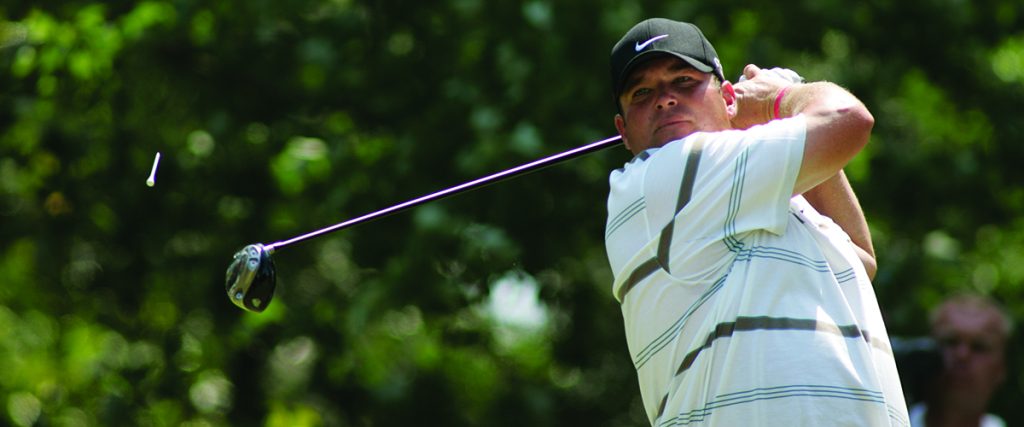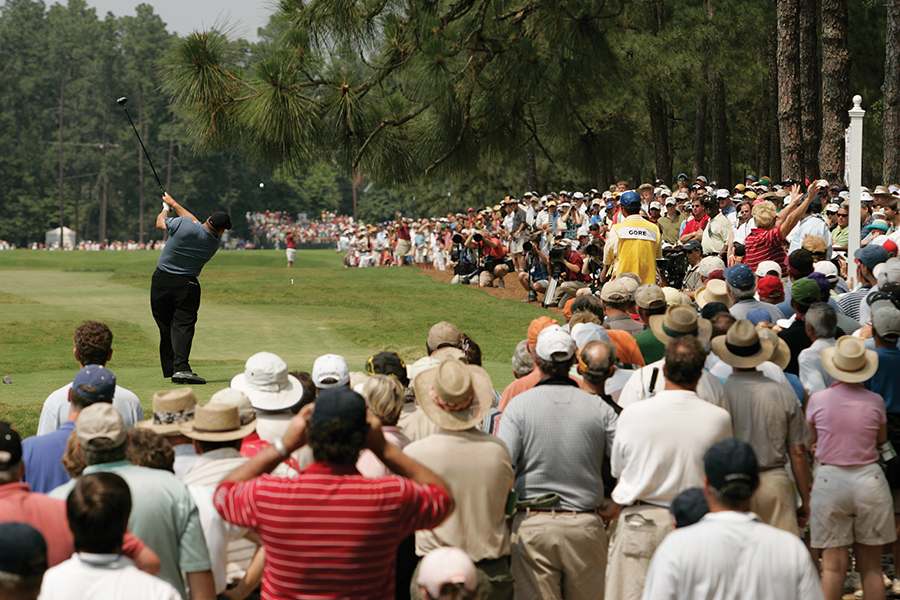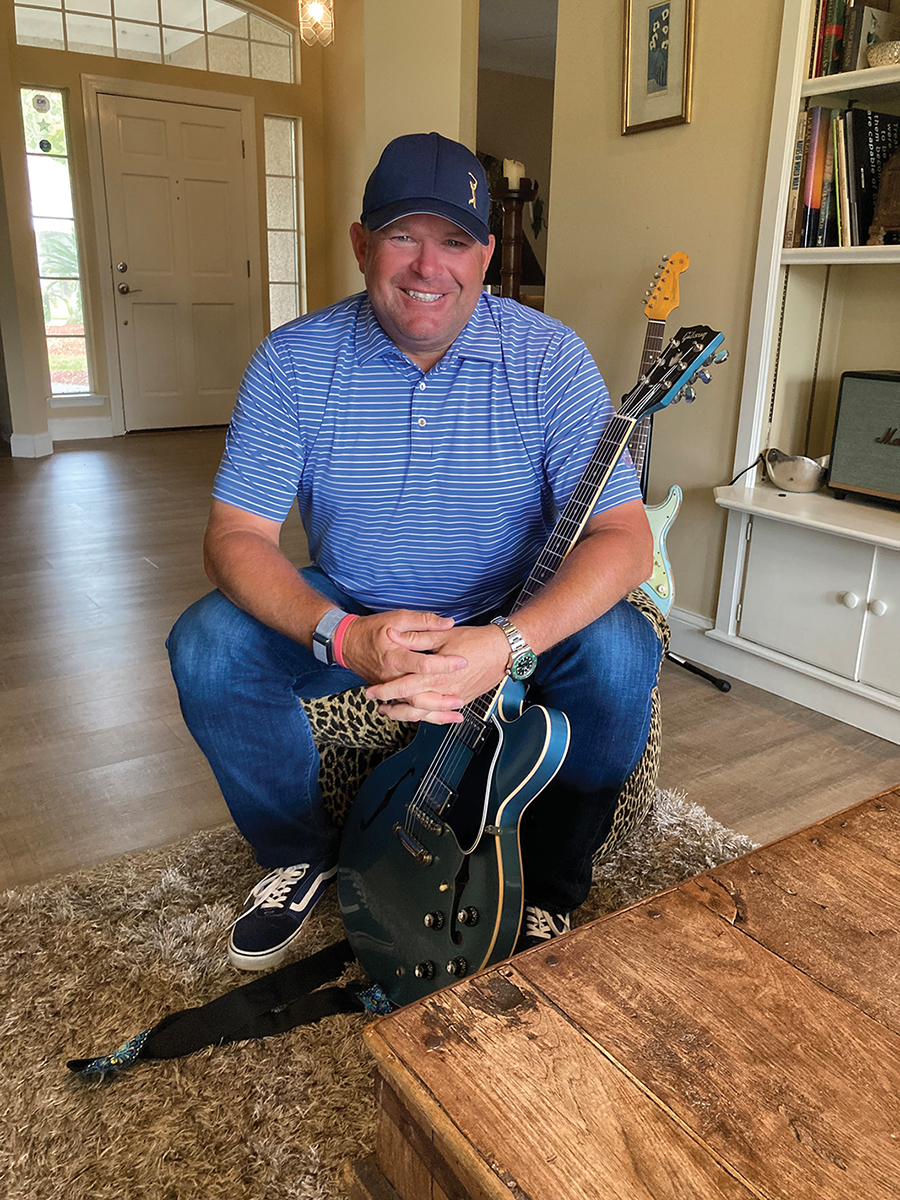
What surprises lurk in Pinehurst’s next U.S. Open?
By Jim Moriarty
Feature Photo Caption: Jason Gore on the fourth tee in the third round of the 2005 U.S. Open.A U.S. Open is guaranteed to surprise. It’s built into the DNA. Because an Open is just that — open — it is the moon shot destination of every Tin Cup Roy McAvoy, every Caddyshack Carl Spackler, every Goat Hills assistant pro, every whistlestop, RV-driving, 4 o’clock in the morning coffee-drinking golfer with 14 clubs, a rainsuit that doesn’t leak and the most peculiar of ideas: that they can flat-out play this idiotic game. And every U.S. Open will have one of those guys you never heard of up on the leaderboard, posting a low score and a sweet story. In the 2005 U.S. Open at Pinehurst’s No. 2 course, that guy was Jason Gore. And the story was bigger than he was.
A refugee from the PGA Tour’s minor league —the Nationwide Tour in those days — with the thick-chested physique of a stevedore and a neon smile as wide as all 88 keys on a baby grand, Gore’s self-deprecating grace quickly earned him favorite son status when he joined two-time U.S. Open champion Retief Goosen and tour veteran Olin Browne (who may be more famous these days as the father of the country/soft rock singer Alexandra Browne) at the top of the leaderboard after 36 holes. Golf World, the ultimate insider’s magazine first published in Pinehurst in 1947, described Gore as a “cross between Cinderella and the Michelin Man.”
It was an apt description, since the tires were among the few things left when Gore’s car was ransacked in Asheville en route to the national championship he would make, in many ways, his own. After getting through second stage qualifying in Atlanta, Gore flew to Knoxville, Tennessee (site of that week’s Nationwide tournament), to pick up his car, a black Ford Expedition with dark tinted windows and fancy chrome wheels. He, wife Megan and their 8-month old son, Jaxson, who was sporting two ear infections, headed east on I-40. “There was a thunderstorm coming through and it’s 2 o’clock in the morning and the walls are starting to close in,” Gore recalls, so they stopped and checked into a hotel.
Exhausted, they left most of their belongings in the car. In the morning Megan went to get a change of clothes and came back in tears. “They’d punched out the keyhole on the driver’s side and popped it open, tore out the dash, the Alpine stereo, took everything except the baby seat,” says Gore. “They cut themselves when they were tearing out the dash and there was blood and wires hanging everywhere.” Missing were all of Megan’s clothes and Jason’s briefcase with his laptop and his U.S. Open credentials. As luck would have it, his clubs had gone ahead of him with his caddie, Lewis Puller.
Gore rolled into Pinehurst in the jerry-rigged SUV version of Apollo 13, talking his way past a phalanx of security guards. “Go ahead,” one uniformed officer finally told him, “we heard about you.” By the weekend, every golf fan in America had.
Gore was the kind of player known to golf’s cognoscenti, if not to the general public. He and his Pepperdine University teammates won the NCAA team championship at Conway Farms Golf Club in Chicago in ’97, with Gore making double bogey on the last hole to lose the individual title to Clemson University’s Charles Warren by a shot. He won the California State Open and California State Amateur that year along with the Pacific Coast Amateur. His accomplishments earned him a spot on the victorious U.S. Walker Cup team at Quaker Ridge Golf Club where he accounted for 2 1/2 points. Then, the morning he was leaving for Boise, Idaho, to play in his first professional event, his mother, Kathy, found his father, Sheldon, on their living room floor dead from a heart attack.
“I had kind of a rough start to my golf career,” Gore told the media in ’05 when speaking about his father. “It’s taken a little while to get over that and try and become myself again.” At the age of 31, Gore had already bounced back and forth between the PGA Tour and its primary satellite twice. That he could play well wasn’t a shock. But could he play well enough to win a U.S. Open?
After his second round of three under par 67, Gore low-keyed it by describing the other time he led the U.S. Open. He was one of the first players on the course at the Olympic Club in ’98, drove it through the fairway into a bunch of “crap” (as he described it) on the opening hole, pitched out and holed a 90-yard wedge shot for a three. There was a leaderboard on the second tee and his name was at the top. Gore with a red -1. “So, this is old hat for me,” he said with that wide grin. His run in ’98 was short-lived. A 77 that day put a quick end to his Olympic feats.

Jason Gore tees off on the second hole during the final round of the 2005 U.S. Open.
On Friday evening Gore made a foray to fill his car with gas and get a prescription at Eckerd’s for Jaxson’s ear infections. Had he been promoted to recognizable celebrity status? “I got a couple of waves when I was putting gas in the car,” he deadpanned.
Unknown to Gore, on Saturday while he was on the course the Golf Channel had his Expedition cleaned and pressed. “They took my truck, fixed the air conditioning and put a new stereo in. It was so awesome,” he recalls. “They had me up on set on Saturday night after I played and showed me the video. It was Rich Lerner. Rich covered the NCAAs in ’97. We were all kids. It was just the nicest gesture. I’ll never forget that.”
Lerner, golf television’s most gifted essayist, has fuzzy recollections of their good deed. “I do remember that being a part of the J. Gore story that everybody fell in love with — how good-natured he was about all of it,” Lerner says. “He was down on his luck but he didn’t wear it that way. He came across as a guy who had all the good fortune in the world and that’s what I think resonated with so many people.”
Gore’s two-over-par 72 on Saturday put him at level par for the championship and three shots behind the leader Goosen, the odds-on favorite to add Pinehurst to the championship venues he’d collected at Southern Hills Country Club and Shinnecock Hills Golf Club. They would be playing together in the final twosome on Sunday. That it was Father’s Day was not lost on Gore.
It didn’t go well for either player. Goosen, the quiet, intense South African who, as a young boy, survived being struck by lightning, didn’t survive Pinehurst’s greens. His 81 dropped him from first to a tie for 11th and opened the door for the eventual champion, New Zealand’s Michael Campbell, to stroll through.
It was worse for Gore, described this way by Golf World: “The solid tee-to-green game Gore had sustained for three days abandoned him, and he hit only four fairways and eight greens. Despite a front nine 40, Gore still was only three off the lead, but four bogeys, a double and a triple coming home — capped off by a sloppy four-putt on the 72nd green — made for a sour end to his dream.”
That four-putt also cost him five bucks. “We hadn’t had much to say to each other all day,” Gore remembers of his Sunday with Retief. “We’re in the final round of the Open so we’re not going to talk about the weather, right?” Then, as they were walking from the 15th green to the 16th tee, both having played themselves out of it, Goosen turned to Gore and said — and here Gore produces a very fine South African accent in his retelling, “Have you ever played cricket?” Gore told him he hadn’t, to which Goosen replied, “We’re having a helluva a day of cricket because we both have so many overs.”
Gore started laughing and asked Goosen if he wanted to play the last three holes for five bucks. Might as well play for something, right? That made Goosen laugh. And so the game within the game was on. They were tied playing the 18th where Gore’s four-putt six lost to Goosen’s par four. Did he pay off? “I saw him at the TaylorMade trailer at Disney. I walked in and handed him five bucks. He laughed and took it,” says Gore. As luck would have it, they were paired together two years later in the final round of The Players Championship. Gore asked if he could get his five bucks back. Goosen said sure. Gore shot 70 and finished T23. Goosen shot 71 and ended up T28. “I still haven’t seen my five bucks,” Gore says with that Cheshire cat grin. “At this point I don’t even want him to pay me because it ruins the story.”

Jason Gore at his condo in Florida
After his final round 84, after Campbell had wrapped his arms around the silver trophy and Tiger Woods’ caddie, Steve Williams, had wrapped his arms around his fellow New Zealander Campbell, after the throngs had fled the village of Pinehurst, Gore stopped in the dark downstairs bar at Dugan’s Pub for a quiet beer and even quieter reflection. “That day was such a blur,” he says. “It’s not that I didn’t play well, I just played incorrectly. I tried to win which, at Pinehurst in a U.S. Open, you don’t do that. You have to stick to your game plan. I learned a lot that day.” After Dugan’s Gore went back to his hotel room at the Pine Needles Lodge. Campbell, joined by a cast of thousands, was in the room directly above Gore’s. “I got to hear him party all night,” he says.
Turning a negative into a positive was something Gore had done after losing the NCAA individual title and he did it again after losing the U.S. Open. He won three times on the Nationwide Tour in July and August of ’05 (his seven career wins on the developmental tour are still a record), then won the 84 Lumber Classic in September for the only PGA Tour victory of his career. Though Gore was born and raised in California, his mother was from Monroeville, east of Pittsburgh, not too far from the Nemacolin Woodlands Resort, site of the 84 Lumber. Gore visited for a month every summer as a kid, cutting his teeth at nearby Manor Valley Golf Course. He was the favorite son once again.
“After I won, I thought I had to continue to get better and do more stuff and I kinda lost my game,” Gore says. Shoulder and back injuries didn’t help. By 2018, he was in the insurance business. Then the USGA came calling, asking Gore to become its first managing director of player relations, a position he held for three-and-a-half years before taking a similar job — senior vice president, player adviser to the commissioner — at the PGA Tour. People who run championships often don’t see things the way people who play in them do. Gore has helped both organizations clear that hurdle.
“My wife and I were high school sweethearts. We grew up in Southern California, born and raised there,” says Gore, who moved east with Megan, Jaxson and his sister, Olivia, after the USGA hired him. “Until we lived in New Jersey I thought snow came out of those machines.”
Now Gore has temporary digs in Ponte Vedra, Florida, and commutes back and forth to New Jersey. His personal possessions in the condo are sparse: a wooden block with Vin Scully’s farewell line from his last L.A. Dodgers’ game and a few guitars. Musically, Gore refers to himself as a 12-handicap. “I’m the guy who shows up in the pro-am with the $10,000 set of clubs and thinks he’s going to beat the pro. That’s me with guitars. You walk into my house in New Jersey, you’d think Slash lived there. I just think they’re works of art. I love them.”
Gore describes his son, Jaxson — he of the double ear infections who’s almost 19 now — as someone with high-functioning autism. “He writes screenplays. We got him a talk-to-text. He’s super, super sharp but there’s a chance he could live with us for the rest of his life, which is fine. He can’t cook an egg but he makes up for it in so many different areas. He sees life through a different set of glasses and it’s awesome. He’ll sit in the basement and just write and create and I’m, ‘Come on, Jax, let’s go out somewhere and see reality.’ And he goes, ‘Dad, I don’t really like reality.’ And I’m like, ‘Yeah, me neither.’”
In 12 months, Pinehurst No. 2 will become reality once again for the best players in the world. “It’s the U.S. Open,” said Gore in 2005 with a grin that still refuses to vanish, “crazy things happen.”
If we’re lucky. PS
Jim Moriarty is the Editor of PineStraw magazine. He can be reached at jjmpinestraw@gmail.com.
